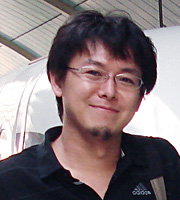Up to now, I have been carrying out various studies to develop an artifact that can create an intimate
interaction with users, and one that can become "the one and only" or "indispensable" one for users.
My collaborators and I advocate these kinds of studies as a "human-agent interaction (HAI)" research
area, and recently, studies on HAI are drawing keen attention from various research fields such as
cognitive science, artificial intelligence, and human interfaces. Within HAI studies, I have been
focusing on achieving a mutual adaptation process between users and artifacts. That is, they continue
to learn to respond more appropriately to each other' behaviors.
It can be said that these studies focused on "how artifacts adapt to users," e.g., how artifacts
should behave in front of users.
However, conducting studies in only the above research direction is not enough to achieve a mutual
adaptation process between users and artifacts. Therefore, conducting studies about "how artifacts
induce users' adaptations," e.g., how should an artifact induce the users' natural speeches, is an
absolutely necessity. Actually these kinds of studies have not been recognized as an important issue
in HAI and various related research fields, though the studies about "how artifacts adapt to users"
has. Therefore, I am planning to conduct or am in the process of actually conducting the following
studies:
->Proposing a methodology or a computational model to induce users' emotional involvement or their
empathy toward the artifact by means of users' biological signals or biofeedback
->Investigating what kinds of subtle expressions can induce a user's appropriate behaviors
unconsciously or implicitly by extending studies on applicant's subtle expressions
->Proposing a meaning acquisition model that can figure out the subtle nuance of the users' intuitive
or unconscious expressions, such as onomatopoetic expressions or prosodic information
->Investigating how the relationship between the artifacts' appearance and its own function affects
the user' impressions
These studies will complement the current researches and could contribute to achieving a mutual
adaptation process between users and artifacts. Moreover, these studies inducing humans' emotional
involvement into the interaction could provide fresh perspectives on current HAI studies and various
related studies in which most researchers have focused on the methodology to make artifacts clever.
Therefore, I assume that these studies can be transmitted as my original research from Shinshu
University to the world.
Profile

Takanori KOMATSU
- Research Area:
- Informatics/System/Mechanics
- Keywords:
- Human-Computer Interaction, Cognitive Science, Affective Computing
- URL:
- http://www.tkomat-lab.com/
Employment Experience:
2003 - 2007. :
Research Associate
School of Systems Information Sciences, Future University-Hakodate, Japan
School of Systems Information Sciences, Future University-Hakodate, Japan
2001 - 2003. :
Junior Research Associate
Laboratory for Behavioral and Dynamic Cognition, Brain Science Institute, RIKEN (Institute of Physical and Chemical Research), Japan
Laboratory for Behavioral and Dynamic Cognition, Brain Science Institute, RIKEN (Institute of Physical and Chemical Research), Japan
1997 - 1999. :
Guest Researcher
Technical University of Vienna, Austria (Participated in a joint study between the University of Tokyo and TU Wien)
Technical University of Vienna, Austria (Participated in a joint study between the University of Tokyo and TU Wien)
1997 - 1999. :
Non - EU Researcher
Profactor Produktionsforschungs GmbH, Styer, Austria
Profactor Produktionsforschungs GmbH, Styer, Austria
Education:
2003
Ph.D. in Interdisciplinary Studies (including Computer
Science, Cognitive Science)
The Graduate School of Arts and Sciences, the University of Tokyo
The Graduate School of Arts and Sciences, the University of Tokyo
1997
Bachelor of Engineering (Mechanical Engineering)
Department of Mechanical Engineering II, Shibaura Institute of Technology, Tokyo, Japan
Department of Mechanical Engineering II, Shibaura Institute of Technology, Tokyo, Japan
Selected Publications:
- Komatsu, T., Ohtsuka, S., Ueda, K., and Komeda, T. (2007). Comprehension of Users' Subjective Interaction States during their Interaction, In Proceedings of the 2nd International Conference on Affective Computing and Intelligent Interaction (ACII2007), pp.168-279.
- Komatsu, T., and Morikawa, K. (2007). Entrainment in the rate of utterance in speech dialogs between users and an auto response system, Journal of Universal Computer Science, vol.17 (2), 186-198.
- Komatsu, T. (2006). Audio subtle expressions affecting user's perceptions, In the Proceedings of the 2006 International Conference on Intelligent User Interface (ACM-IUI2006), pp. 306-308.
- Komatsu, T., Utsunomiya, A., Suzuki, K., Ueda, K., Hiraki, K., and Oka, N. (2005). Experiments toward a mutual adaptive speech interface that adopts the cognitive features humans use for communication and induces and exploits users' adaptation, International Journal of Human-Computer Interaction, vol.18 (3), 243-268.
- Komatsu, T. (2005). Can we assign attitudes to a computer based on its beeps?, In the Proceedings of the Nineteenth International Joint Conference on Artificial Intelligence (IJCAI-05), pp. 1962-1963.
Research Statement
Why this tenure-track position?
I have applied for this position because of the following two reasons;
- An favorable environment for extending my current researches and transmitting these results to the world is provided.
- An favorable opportunity to brush-up my teaching skill is provided. And also the location of Ueda city, Nagano pref. where is about the center of Japan, so that this would facilitate various collaborations with researchers in/out of Japan. I am very honored to be selected in this position.
My goal:
I would like to push strongly forward with my researches to be a researcher who is active internationally in this favorable environment through the collaboration with researchers in/out of Japan/Shinshu University.